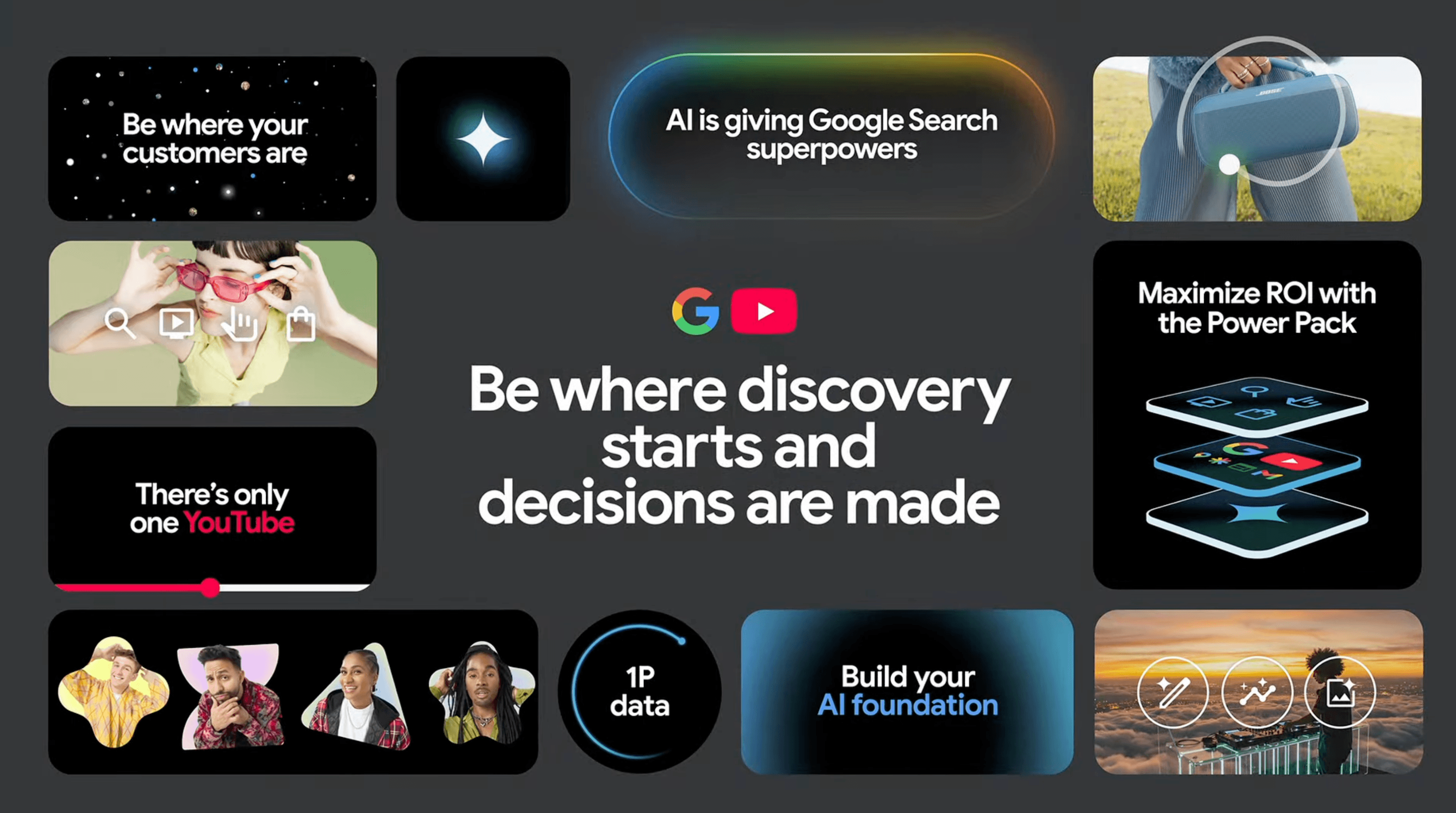Advertising
We drank the Google-AI(de) at GML 2025, did you?
Written by IMM ·
May 2025

IMM’s veteran ad strategists share tips on using Google’s AI tools for performance, content, data, and more.
If Google has anything to do with it, the way you buy absolutely everything will feel like you’ve time-traveled into a sci-fi flick—only with fewer aliens and more algorithms.
Last year was a teaser; GML 2025 delivered the full feature film. The keynote’s mantra? Automate like a zealot, measure like a detective. But unchecked automation can bleed budgets.
Below, we break down the real impact of each major announcement, then give you clear steps to put the new tools through their paces without surrendering all control.
Google’s big bet on advertising automation - The Power Pack
Google's Power Pack is a complete, AI-driven campaign toolkit built to deliver scalable, full-funnel results across all Google touchpoints. They promise plug-and-play reach across Search, YouTube, Display, Discover, Gmail and Maps. Great—until your budget runs wild.

The lineup includes:
- AI Max for Search: Dynamically match broader, intent-driven queries without extra keyword lists, effectively “supercharging” Search campaigns at the click of a toggle.
- Performance Max: A single, goal-based campaign that uses Google’s AI to access all ad inventory—Search, YouTube, Display, Discover, Gmail, and Maps—in one fell swoop
- Demand Gen: The upper-funnel complement runs ads across immersive surfaces (YouTube Shorts, Discover, Gmail, Maps) with lookalike segments and animated formats to spark engagement before users even search
The idea is to use the Pack as a coordinated strategy for reaching customers at every stage of the journey–the cincher is that it requires very minimal setup or oversight from a human ad manager.
These tools aim to take the guesswork out of campaign planning by broadening match types, automating placements, and expanding your ad reach. Sounds great, right? Maybe. Like any good power tool, they come with serious potential and a few safety warnings.

1. AI Max for Search: Google Search is evolving beyond its traditional role.
With the addition of AI Overviews and AI Mode, search now serves as a virtual assistant that can synthesize information, suggest products, and even take next steps for users. These updates mean marketers can now surface ads in places they couldn’t before—directly inside conversational search responses.
Key gains
- AI Overviews & Mode ads on desktop (U.S. only).
- AI Max beta (Ads end-May; SA360 Q2) nets 14% more conversions (up to 27%) at similar CPA/ROAS; organic clicks (particularly publisher site traffic) dropped 34% in Ahrefs’ study of 300K+ keywords—challenging Google’s engagement claims
- Still missing: granular keyword control; monitor for churn.
Note: AI Max doesn’t eliminate keyword targeting; it simply broadens the pool of intent-driven queries your ads can match, taking some guesswork out of search, but not replacing a smart keyword strategy.
With 100B+ monthly Lens searches (20% commercial intent), crisp product images are non-negotiable.
If you're running Performance Max, Shopping, or Broad Match campaigns, your ads may already be eligible for these new placements.
“It's also important to clarify that these updates don’t mean the end of keyword targeting. With AI Max, Google is simply expanding the kinds of queries your ads can match—especially broader, intent-driven phrases. This takes some of the guesswork out of search but doesn’t replace a smart keyword strategy.” - Marion Assaf-Robert
2. Performance Max: A (slightly) clearer picture
After “hearing” complaints from so many, Google is finally making strides toward more transparency in this notorious black box.
How? Advertisers now have access to channel-level reporting, showing impressions, clicks, and conversions by placement. Which means we finally have visibility into where performance is actually happening across Search, YouTube, and Display.
And asset-level reporting is rolling out, providing detailed metrics such as cost, impressions, clicks, conversions, and CPC. These updates are likely to drive way more PMax adoption in the future.
Search term reporting is now extended to PMax, so advertisers can see which keywords triggered ads and exclude underperforming queries.
Key gains
- Open-beta channel reporting breaks out Impr./Clicks/Conv. by network; includes search-term insights & negatives
- Asset metrics (cost, CPC, conversion value) expose your creative winners.
- Still missing: spend-by-channel visibility & manual budget splits.
Challenge: More data doesn’t always equal more control—advertisers still can’t reallocate budgets by network or layer in granular keyword targeting, so insights can outpace actions.
Your next steps:
- Review channel splits weekly; swap or retire low performers.
- Exclude wasteful queries from PMax.
- Feed first-party data via Tag Gateway/Data Manager.
These enhancements are a welcome shift toward control—but there are still limitations.
"While these visibility improvements are a big win, they’re not yet matched by full control. That gap between insight and action is one of the biggest hurdles with PMax today." - Hailey Mathieson
Advertisers still can't manually adjust keyword targeting or allocate budget across individual channels. We’re optimistic about where things are heading, but for now, marketers need to balance automation with close oversight.
3. Demand Gen: Now with more flexibility
Demand Gen is Google’s answer to modern upper-funnel marketing, including prospecting. Designed to drive awareness and engagement, these campaigns now appear across YouTube, Discover, and Gmail—providing more access to high-impact, visual-first placements.
Key gains
- Ads in YouTube, Discover, Gmail & Maps for immersive reach
- Animated formats & templates boost top-of-funnel engagement.
- Still missing: fine-grained placement exclusions.
Your next steps:
- Run a small awareness test; measure reach + lift.
- Build lookalike audiences from first-party signals.
- Monitor placements; pull back low-ROI spots.
Also worth a pilot
We can’t ignore the other AI and automation goodies unveiled at GML—Smart Bidding’s new exploration mode, YouTube’s shoppable Shorts, AI-powered creative agents, and streamlined incrementality testing in GA4 and beyond.
YouTube + Shorts: Swipe, shop, repeat
YouTube Shorts is quickly becoming a shoppable space, allowing users to browse and buy products directly from short-form content. These ads now reach users on both mobile and connected TVs, making it easier to link discovery and conversion.
Google also launched the Creator Partnerships Hub—which lets brands discover and collaborate with influencers in-platform. This opens doors to influencer marketing and user-generated content without having to rely on third-party platforms.
Your game plan: If your brand hasn’t tapped into Shorts yet, now’s the time to consider it. Use Shorts to test performance across different creative angles and explore shoppable formats for direct response.
Early adopters report +18% more unique query categories and +19% more conversions (at a 10% lower allowable ROAS) when turning on exploration mode
That said, attribution remains a challenge. Short-form video tends to work better for driving awareness than immediate conversions, so be sure to test carefully and look for downstream impact.
Creative at Scale: AI joins your studio team
Google has integrated generative AI tools into both Product Studio and Google Ads, enabling advertisers to take static product images and turn them into engaging video clips and automatically generate titles, promotions, and campaign ideas.
The updated Merchant Center now includes visual brand profiles, giving marketers more control over how their brand appears on Search and Google Shopping. This includes curating images, videos, and reviews into a unified presence across Google surfaces.
Your game plan: To get the most from these tools, start by experimenting with AI-assisted creative to improve scale. However, don’t skip quality control—review all assets to ensure brand alignment and relevance to your target audience.
While AI can speed up production, the output can sometimes miss the mark. Avoid relying on it entirely for visual storytelling, and use it to support your creative strategy rather than replace it.
Smart Bidding: New signals, new paths
Beyond campaign execution, Google is now introducing AI-powered agents designed to support both planning and analytics. On the campaign side, these assistants can recommend keywords, generate creative ideas, and even build out fully themed ad groups based on your goals—essentially giving you a head start on campaign setup.
Over in analytics, a new AI "data expert" acts like a smart overlay on GA4: it surfaces patterns, highlights performance trends, and helps diagnose what’s working (or not), providing insights that marketers can act on with more confidence.
Smart Bidding just got smarter. Google’s latest update enhances the system’s ability to identify underutilized, high-potential search queries. Instead of just focusing on obvious, high-intent terms, this upgrade helps advertisers reach users earlier in the buying journey.
By tapping into these previously overlooked queries, brands can connect with customers before their competitors even know they exist. Combined with flexible ROAS targets, Smart Bidding now offers more nuanced control over who sees your ads and when.
Your game plan: To maximize this opportunity, test the new capabilities in select campaigns where broader targeting is less risky. Monitor your query reports closely to evaluate performance and maintain relevance.
Still, more automation means more unpredictability. Expect to find some mismatched queries in the mix and adjust accordingly.
Measurement & Attribution: More Clarity, Less Guessing
Google has made major strides in campaign measurement and attribution this year. Marketers can now run incrementality tests with budgets as low as $5,000—a significant improvement in accessibility. GA4 is also leveling up, offering cross-channel attribution reports and smarter budget allocation suggestions.
Meanwhile, Ads Data Manager is emerging as the new hub for data integration. This tool connects first-party data from CRM systems, analytics tools, and eCommerce platforms in one privacy-safe environment, simplifying performance tracking and personalization.
Your game plan: Brands should start leveraging these new capabilities by setting a regular cadence for lift testing, ensuring clean and accurate data collection, and making data-backed shifts in budget allocations.
But remember: even the best tools won’t deliver value unless they’re actively used. Prioritize setting clear benchmarks and adopting a test-and-learn approach to make the most of Google’s measurement evolution.
Promise & Peril: The True Trade‑Offs
GML 2025 made one thing crystal clear: AI isn’t a feature. It’s the foundation. And while the tech is impressive, success still hinges on smart marketers asking the right questions, testing rigorously, and staying agile.
Promise:
- Scale without complexity. Broader match types and dynamic placements unlock new pockets of demand with minimal setup.
- Actionable insights. Channel‑ and asset‑level metrics bring much‑needed transparency to once‑opaque campaigns.
- Smarter creative & measurement. AI agents and streamlined incrementality testing can accelerate ideation and benchmark ROI faster than ever.
Peril:
- Control loss. Automated engines can drift toward irrelevant spend if left unchecked—your budget, your rules.
- Complacent measurement. Sophisticated attribution means nothing without strict baselines and ongoing lift testing.
- Brand dilution. AI‑generated ads risk sounding generic—maintain a human‑in‑the‑loop for all creative output.
6 Key Takeaways:
- Google’s Power Pack is powerful, but not a plug-and-play solution.
- Automate boldly—but pilot everything.
- Obsess over data. Lock in benchmarks before scaling new tools.
- Retain manual override. Keep a finger on the budget and the messaging to ensure alignment with your brand’s core values.
- Transparency is improving, so use it to take control.
- Your first-party data and creative strategy matter more than ever.
At IMM, we help performance-driven brands navigate this ever-shifting landscape. From testing AI tools to refining measurement, we ensure innovation aligns with real results.
Let’s talk if you’re ready to turn AI ambition into actual growth.

Share this post


